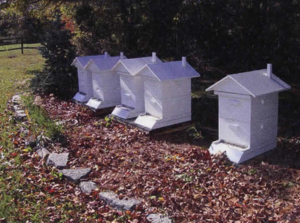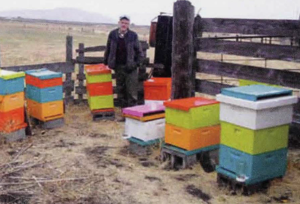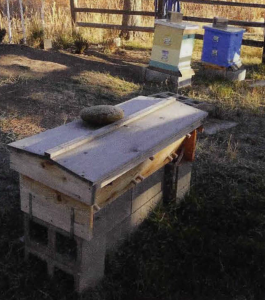By: Dewey Caron
This article originally appeared in the Autumn 2016 issue of BEEKeeping Your First Three Years
Electing not to treat bees or seeking to move toward treatment-free is one of several possible options in bee colony stewardship. Managed colonies, along with bee colonies in the wild, experience heavy overwintering losses. It seems that one treatment regime doesn’t work in all instances and some consider that treatment is not the “solution.” Consequently Treatment-Free conferences on both coasts have grown in popularity, and at state, regional and national meetings there may be one or several talks covering treatment-free. Four new books on top-bar beekeeping, colonies largely managed treatment-free, have been published in the last couple of years.
Tom Seeley, at a recent treatment free conference in Forest Grove, OR described his research on where and how bees live in the wild in contrast to what we “require” of those same bees when we site them in our apiary. He believes keeping bees more similar as occurs in nature is smart beekeeping. He is researching why bees in the wild seem to accommodate more to mites and begin to survive in a more balanced equilibrium with mites.
In his forward to Steve Repasky’s recent book on swarming (Wicwas Press), Tom expressed this concept as follows:
“When we beekeepers put a colony of bees in a hive, we gain control over where they live and we make it easy to open their nest and do what we want, but we actually gain little control over the bees.”
In the wild, escaped beekeeper swarms must find a suitable cavity, grow in strength and store enough reserves to overwinter. They must also deal with mites and other diseases, as not doing so results in colony death. The strong survive; earlier studies by Dr. Seeley estimated only one in five survive the first season. During better weather in the Spring, the bees thrive and emit swarms to repopulate vacant cavities. Surviving colonies grow in strength with Spring resources and seek to store enough reserves to overwinter.
Beekeepers generally wish to improve the odds of colony survival. How do we assist our managed hives to be survivors? As experienced beekeepers know, there is more than one way to assist bee colonies. We provide comfortable domiciles (hives), we supply drawn comb to splits and captured swarms, we feed supplemental sugar, we bolster brood populations and we can seek to minimize the impact of predators and diseases.
We can elect to treat for diseases/mites and provide supplemental feed when colonies lack adequate stores or we wish to bolster/stimulate weaker colonies. Not treating or working toward not treating colonies, if you are currently treating and wish to reduce doing so, or want to start new colonies without treating, are perfectly good options in our striving to reduce our continuing heavy bee losses. If we do not wish to treat, can beekeeping still be profitable and colony stewardship fun?
Keeping bees without or with minimal treatments, a desire of the majority of small-scale beekeepers in my survey experience, lies, I believe, in considering four components – the beehive, the apiary, the bee stock and finally our approach to colony stewardship.
THE HIVE
Our Langstroth hive is considered both the greatest advance in modern beekeeping and yet it probably helped contribute to great epidemics of disease (think the American Foulbrood epidemic in the early part of the 1900s in the U.S. and in the late 1800s in Ireland or Isle of Wight Disease epidemic (often ascribed as due to tracheal mites) in Europe in the 1920’s). The increased adoption of Langstroth movable comb hives of course was not in isolation with other advances in beekeeping that may equally have contributed to disease spread and these epidemics. Could the Langstroth hive (combined with how we have changed our beekeeping) be a contributory factor to the current loss epidemic, ascribed as due to a combination of factors but most surely Varroa mites and their transmission of viruses?
Treatment-free advocates often champion a different hive, such as top-bar hives. In the last two years, four books on top-bar hive beekeeping have been published alone. Top-bar hives are seldom opened (particularly after they are larger), frames or bees are not moved (within or between hives), and treating for mites or diseases or even feeding is not practical (although some techniques have been described to treat or feed). The hive encourages less intervention. A number of beekeepers now include both types in their backyard apiaries and wait the results to see if a different hive makes a difference.
In reality the type of hive to use might be dictated by the intentions of bee stewardship. Not all beekeepers desire or seek large populous colonies, with highly interventive management nor do all beekeepers seek to maximize the potential honey surplus or use their colonies multiple times in planned pollination. Smaller colony populations, heavier swarming and losing colonies is considered part of normal beekeeping.
Although the Langstroth hive is most practical for colony manipulations and larger-scale beekeeping, it is not necessarily the best one for all beekeepers. The Langstroth hive might be better utilized for beekeepers wishing to work toward treatment-free beekeeping by moving frames less, keeping colonies weaker and planned interruption of the brood cycle. So although not necessarily the hive, how we manage the hive, the way we site it and our interventions might be reevaluated if we seek to reduce treatments.
THE APIARY
It seems clear that keeping bees in similar boxes, all painted white, six inches to two feet above the ground, in neat even rows, without distinguishing identification features (for the bees not the beekeeper) promotes drifting and with it disease and mite spread. Bees in the wild are ½ mile apart in different trees at different heights above the ground. Drifting and robbing are not common behaviors of wild colonies but they are in our apiaries.
Manipulations, siting, hiving bee colonies in a small area, all with a common bee stock, seeks to make colonies more similar than dissimilar, consequently making treatment intervention more necessary to reduce heavy losses. Distinctive hives (whether all Langstroth design or mixture of hive types) and distinctive siting in the apiary are practical, non-expensive things we can do to work toward treatment-free beekeeping.
Apiaries with colonies facing different directions, with different numbers of boxes, each distinctly colored or patterned, spaced apart as the site allows, elevated differing distances off the ground or otherwise made distinct from every other nearby hive all represent smart beekeeping and may assist in working toward treatment-free bee culture. Mites, disease, drifting bees and competition all come from nearby neighboring colonies. Reducing sameness and promoting differences, when practical, is good bee stewardship.
We can read our colonies when we enter the apiary and not open colonies if there is no need to do so. Elevation reduces pest pressure and helps keep entrances more accessible to the bees. A simple yellow jacket trap (where these predators are common) can help reduce this stressor for our colonies. Sunshine reduces Varroa numbers and may help reduce disease pathogens. Think bee comfort and give bees a chance to fight back.
BEE STOCK
We can train bees to visit certain crops and to detect landmine chemicals, even certain human diseases. We have bred a better alfalfa pollen collector, bees that are more resistant to AFB disease, bees that are more hygienic (and fight mites more effectively), bees that are more productive and we have bees that use less propolis. We have imported bees into the U.S. that are better defenders against Varroa mites. Why then, do we persist in purchasing bees from the same source to replace overwinter losses or simply divide survivors and allow them to raise their own queen?
Everyone agrees that our eventual mite “solution” will be bees that can live in better harmony with mites. We have bees that, to a limited degree, resist mites. It is possible for individual beekeepers to breed from survivors that have better mite resistance. Bee breeders are working toward the better bee but we still have a ways to go. If we are going to work toward treatment-free or do not wish to treat our bees for mites, it seems clear we will continue to suffer heavy losses (30+% annually overwinter, 45% annually, from our national surveys).
Our role should be to support those programs and purchase those queens/bees that are the better stock. Treatment-free means using better stock. As with much of beekeeping there is no one answer, no one stock that meets all our needs, including the ability to resist mites. For some beekeepers the better stock might be Carniolan bees, Russian queens, or hygienic stock, coupled with seeking to raise our own survivor queens. We need to speed the development of bees resistant to mites.
HIVE MANAGEMENT
We can change our apiary and make our hives look different for the occupants, less carbon copy-like, plus we can seek a better, more appropriate stock but it is our management that we can most easily change if we wish to treat less or not at all.
What can we change? Nothing will be easy – change takes us out of a comfort zone. We can seek to raise drones as a mite trap and cull capped drone brood as a management. It can help reduce the growing mite population. It is work. We can seek to keep colonies growing by dividing colonies and introducing the improved stock. Growing colonies give the bees the opportunity to “grow out” of their mite problems. This too is work. We can seek to inspect and understand the needs of our individual colonies rather than seek to make them all the same. Less transfer of frames (unless we move honey to help bolster colonies with fewer stores to improve overwintering success) is better stewardship.
Quicker, more directed inspections can be useful as well. Opening the colony is a stressor for the bees. Disruption of the normal brood pattern stresses bees. We do not need to see the queen to know our colony is queenright – we only need to see normal egg laying and the pattern of the brood nest to confirm all is OK in the colony. Simple may be better.
Larger-scale beekeepers feel aggressive Varroa treatment necessary to have sufficient colonies to be economically viable. Mite numbers can explode in colonies in the early Fall leading to colony crash in early Spring. Working toward treatment free may necessarily involve keeping mite populations under control in concert with other measures to reduce losses. There are alternatives for mite control and some treatments may be more “acceptable.” They are not as easy to use and may not provide as effective control of Varroa but could help make a difference.
Not all beekeepers need or desire large populous colonies. Smaller, growing colony populations and keeping weaker colonies, with fewer inspections, may better serve the beekeeping goals of many smaller-scale beekeepers. No single change will solve all beekeeping problems but we should evaluate how we keep our bees and what we do to them as a first step toward less interventive, more successful beekeeping.












